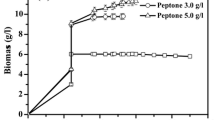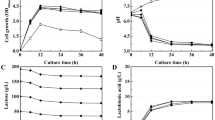Abstract
Lactobacillus brevis 3-A5 was isolated and expected to produce mannitol efficiently by regulating pH in batch and fed-batch fermentations. In 48 h batch fermentations with free and constant pH, the optimal pH for cell growth and mannitol production in the first 24 h of incubation was 5.5, whereas that for mannitol production in the second 24 h of incubation was 4.5. To achieve high cell density and mannitol yield simultaneously, a dual-stage pH control strategy was proposed based on the kinetic analysis of mannitol production. The pH value was controlled at 5.5 for the first 12 h of fermentation and subsequently shifted to 4.5 until the fermentation was completed. Under dual-stage pH control fermentation, a 103 g/L yield of mannitol with a volumetric production rate of 3.7 g/L/h was achieved after 28 h. The dual-stage pH control fed-batch fermentation strategy was further developed to improve mannitol yield, wherein the yield increased by 109 % to 215 g/L after 98 h of fermentation. This value is the highest yield of mannitol ever reported using L. brevis.



Similar content being viewed by others
Abbreviations
- X :
-
Cell dry weight, g/L
- X m :
-
Maximum cell dry weight, g/L
- μ :
-
Specific cell growth rate, 1/h
- μ max :
-
Maximum specific cell growth rate, 1/h
- t :
-
Time, h
- P :
-
Product concentration, g/L
- Q P :
-
Volumetric productivity of mannitol, g/L/h
- α :
-
Growth associated constant for product formation
- β :
-
Non-growth associated constant for product formation, 1/h
- q P :
-
Specific mannitol formation rate, 1/h
- q L :
-
Specific lactic acid formation rate, 1/h
- q A :
-
Specific acetic acid formation rate, 1/h
- q E :
-
Specific ethanol formation rate, 1/h
- P/(L + A + E):
-
Ratio of mannitol to organic acids (lactic acid and acetic acid) and ethanol
- S :
-
Substrate concentration, g/L
- Y X/S :
-
Cell yield coefficient on substrate, g biomass/g sugar
- Y P/X :
-
Product yield coefficient on biomass, g mannitol/g biomass
- Y P/S :
-
Product yield coefficient on substrate, g mannitol/g sugar
- m s :
-
Energy maintain constant, 1/h
- q SF :
-
Specific fructose consumption rate, 1/h
- q SG :
-
Specific glucose consumption rate, 1/h
- Y MDH/X :
-
Specific mannitol dehydrogenase activity on the biomass, U/mg protein/(g/L biomass)
- NADH/NAD:
-
Ratio of NADH to NAD
References
Akinterinwa O, Khankal R, Cirino PC (2008) Metabolic engineering for bioproduction of sugar alcohols. Curr Opin Biotechnol 19:461–467
Cao JM, Chen XC, Ren HJ, Zhang JD, Li L, Chen Y, Xiong J, Bai JX, Ying HJ (2012) Production of cyclic adenosine monophosphate by Arthrobacter sp. A302 using fed-batch fermentation with pH-shift control. World J Microbiol Biotechnol 28:121–127
Fontes C, Honorato T, Rabelo M, Rodrigues S (2009) Kinetic study of mannitol production using cashew apple juice as substrate. Bioprocess Biosys Engin 32:493–499
Geng X, Zhang S, Wang Q, Zhao ZK (2008) Determination of organic acids in the presence of inorganic anions by ion chromatography with suppressed conductivity detection. J Chromatogr A 1192:187–190
Ghoreishi SM, Shahrestani RG (2009) Innovative strategies for engineering mannitol production. Trends Food Sci Technol 20:263–270
Hahn G, Kaup B, Bringer-Meyer S, Sahm H (2003) A zinc-containing mannitol-2-dehydrogenase from Leuconostoc pseudomesenteroides ATCC 12291: purification of the enzyme and cloning of the gene. Arch Microbiol 179:101–107
Liu YP, Zheng P, Sun ZH, Ni Y, Dong JJ, Wei P (2008) Strategies of pH control and glucose-fed batch fermentation for production of succinic acid by Actinobacillus succinogenes CGMCC1593. J Chem Technol Biotechnol 83:722–729
Luedeking R, Piret EL (1959) A kinetic study of the lactic acid fermentation. Batch process at controlled pH. J Biochem Microbiol Technol Eng 1:393–412
Ortiz ME, Fornaguera MJ, Raya RR, Mozzi F (2012) Lactobacillus reuteri CRL 1101 highly produces mannitol from sugarcane molasses as carbon source. Appl Microbiol Biotechnol 95:991–999
Patra F, Tomar SK, Rajput YS, Singh R (2011) Characterization of mannitol producing strains of Leuconostoc species. World J Microbiol Biotechnol 27:933–939
Racine FM, Saha BC (2007) Production of mannitol by Lactobacillus intermedius NRRL B-3693 in fed-batch and continuous cell-recycle fermentations. Process Biochem 42:1609–1613
Ricklefs RE (1967) A graphical method of fitting equations to growth curves. Ecology 48:978–983
Rodríguez C, Rimaux T, Fornaguera MJ, Vrancken G, de Valdez GF, Vuyst LD, Mozzi F (2012) Mannitol production by heterofermentative Lactobacillus reuteri CRL 1101 and Lactobacillus fermentum CRL 573 in free and controlled pH batch fermentations. Appl Microbiol Biotechnol 93:2519–2527
Saha BC (2006) Production of mannitol from inulin by simultaneous enzymatic saccharification and fermentation with Lactobacillus intermedius NRRL B-3693. Enzyme Microb Technol 39:991–995
Saha BC, Nakamura LK (2003) Production of mannitol and lactic acid by fermentation with Lactobacillus intermedius NRRL B-3693. Biotechnol Bioeng 82:864–871
Saha BC, Racine FM (2010) Effects of pH and corn steep liquor variability on mannitol production by Lactobacillus intermedius NRRL B-3693. Appl Microbiol Biotechnol 87:553–560
Saha BC, Racine FM (2011) Biotechnological production of mannitol and its applications. Appl Microbiol Biotechnol 89:879–891
Soetaert W, Buchholz K, Vandamme EJ (1995) Production of D-mannitol and D-lactic acid by fermentation with Leuconostoc mesenterroides. Agro Food Ind Hi Tech 6:41–44
Song SH, Vieille C (2009) Recent advances in the biological production of mannitol. Appl Microbiol Biotechnol 84:55–62
von Weymarn N (2002) Process development for mannitol production by lactic acid bacteria, PhD Thesis. Helsinky University of Technology, Finland
von Weymarn N, Hujanen M, Leisola M (2002) Production of D-mannitol by heterofermentative lactic acid bacteria. Process Biochem 37:1207–1213
Wang RB, Zhang HZ, Qiu HY, Gao SY, Kan B (2009) Proteins involved in difference of sorbitol fermentation rates of toxigenic and nontoxigenic Vibrio cholerae EI T or strains revealed by comparative proteome analysis. BMC Microbiol 9:135
Wisselink HW, Weusthuis RA, Eggink G, Hugenholtz J, Grobben GJ (2002) Mannitol production by lactic acid bacteria: a review. Int Dairy J 12:151–161
Wu Q, Xu H, Ying HJ, Ouyang PK (2010) Kinetic analysis and pH-shift control strategy for poly (gamma-glutamic acid) production with Bacillus subtilis CGMCC 0833. Biochem Eng J 50:24–28
Yue M, Cao HL, Li SG, Yang FL, Zhang JP, Du YG (2012) Mutation breeding of lactic acid bacteria for high yield of mannitol from saccharified Jerusalem artichoke. China Brew 31:53–56
Zaunmüller T, Eichert M, Richter H, Unden G (2006) Variations in the energy metabolism of biotechnologically relevant heterofermentative lactic acid bacteria during growth on sugars and organic acids. Appl Microbiol Biotechnol 72:421–429
Zhou YJ, Wang L, Yang F, Lin XP, Zhang SF, Zhao ZB (2011) Determining the extremes of the cellular NAD(H) level by using an Escherichia coli NAD+-auxotrophic mutant. Appl Environ Microbiol 77:6133–6140
Zhu Y, Cao HL, Yue M, Li SG, Bai XF, Zhao XM, Du YG (2009) The primary study of production of mannitol from saccharified jerusalem artichoke juice with several lactic acid bacteria. Acta Agric Boreali Occident Sin 18:137–141, 175
Zhu LQ, Yang X, Xue CY, Chen Y, Qu L, Lu WY (2012) Enhanced rhamnolipids production by Pseudomonas aeruginosa based on a pH stage-controlled fed-batch fermentation process. Bioresour Technol 117:208–213
Acknowledgments
This research was financially supported by the Main Direction Program of Knowledge Innovation of the Chinese Academy of Science (Grant No. KSCX2-EW-G-5), the National High Technology Research and Development Program of China (863 Program) (Grant No. 2012AA021205) and National Science and Technology Support Program (Grant No. 2012BAD32B09). We thank Dr. Haidong Tan for critical reading of the manuscript.
Author information
Authors and Affiliations
Corresponding author
Rights and permissions
About this article
Cite this article
Yue, M., Cao, H., Zhang, J. et al. Improvement of mannitol production by Lactobacillus brevis mutant 3-A5 based on dual-stage pH control and fed-batch fermentations. World J Microbiol Biotechnol 29, 1923–1930 (2013). https://doi.org/10.1007/s11274-013-1357-6
Received:
Accepted:
Published:
Issue Date:
DOI: https://doi.org/10.1007/s11274-013-1357-6




